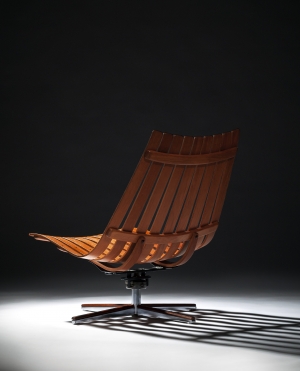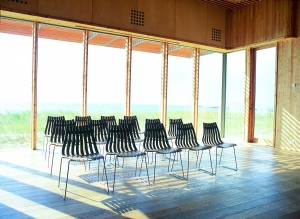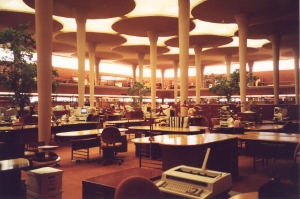|
Displaying items by tag: furniture
The National Academy Museum and School has let go several members of its staff, including both its registrars, the marketing director, the building manager and senior curator Bruce Weber. Dr. Marshall Price, the museum’s contemporary curator, left on his own volition in March to become a curator at the Nasher Museum of Art at Duke University. According to sources with knowledge of the situation, the National Academy’s director, Carmine Branagan, told the museum’s board that the reason the employees were let go was financial, but the real reason stems from disagreements within the institution over its future direction—namely, the promotion of Maurizio Pellegrin, a member of the school’s faculty, to the powerful position of creative director of both the National Academy School and its museum, which are located in a townhouse on Museum Mile.

The Nordic Heritage Museum in Seattle, Washington, is celebrating the classic elegance of Scandinavian mid-century design with the exhibition “Danish Modern: Design for Living.” Organized by The Museum of Danish America in Elk Horn, Iowa, “Danish Modern” features simple and sophisticated furnishings designed and crafted in Denmark in the 1950s and 1960s -- a particularly prosperous period for the style.
The exhibition includes household items such as toys, lamps, and serving pieces, as well as a swath of chairs. Celebrated for its form, function, and consideration for the human body, it’s no surprise that a plethora of iconic chairs originated during the heyday of Danish Modern design. The show at the Nordic Heritage Museum features Arne Jacobsen’s cocoon-like “Egg” chair, graceful “Swan” Chair, and stackable “Seven" chair as well as Helge Sibast’s spindly “No. 8” chair and Hans Wegner’s curvaceous “Round” chair, which was so popular during the middle of the 20th century that it became known simply as “the Chair.”
A unique scholarly institute devoted to Francis Bacon is to open in Monaco, where the painter drew inspiration from the light and landscape, as well as the principality's gambling dens and bars.
The idea of the wealthy Lebanese-born property developer Majid Boustany, the Francis Bacon MB Art Foundation's collection will bring together previously unseen photographs, oil paintings from the 1920s to the 1980s, and furniture and rugs from Bacon's spell as an interior designer. There will also be an extensive library open to scholars and members of the public by appointment.

After successful stints in Oslo and Tokyo, “Norwegian Icons: Important Norwegian Design” is on view in New York City. The exhibition, which is currently taking place at the Openhouse Gallery in SoHo, explores Norway’s contributions to mid-century Scandinavian design. The show includes high-end decorative arts and furniture created between 1940 and 1975 as well as works by Norwegian artists, including Edvard Munch.
Mid-century Scandinavian design is well-known for its clean, simple lines and high functionality. However, there is often little distinction made between the contributions made by each country. While most design enthusiasts are familiar with Arne Jacobsen’s egg chair (Denmark) and Maija Isola’s bold, colorful textiles for Marimekko (Finland), Norway’s contributions to mid-century design often fly under the radar. Organized by Blomqvist, an Oslo-based auction house, and Fuglen, a Norwegian cafe/bar/vintage design shop, “Norwegian Icons” aims to educate the public about Norway’s contributions to Scandinavian design, including Hans Brattrud’s development of Alvar Aalto’s wood-bending technique and Sven Ivar Dysthe’s flat-packed, ready-to-ship furniture.
In 1855, Edward Burne-Jones and William Morris, student friends at Oxford, decided to abandon their theological studies and become artists. They turned for guidance to Dante Gabriel Rossetti, a leader of the recently disbanded Pre-Raphaelite Brotherhood (1848-1853), a group that galvanized British painting by rejecting academic convention and sought to emulate the vividness and sincerity of art from before the time of Raphael.
The creative dialogue between Burne-Jones, Morris, and Rossetti was remarkable for its intensity, productivity, and duration, and stimulated fresh goals and styles that defined the second wave of Pre-Raphaelite art, in the key decades from the 1860s through the 1890s.

Museum of Fine Arts, Houston, Director Gary Tinterow announced an unprecedented exhibition: Houghton Hall: Portrait of an English Country House, which will be on view at the Museum from June 22 to September 21, 2014. The exhibition marks the first time the renowned collection of the marquesses of Cholmondeley, housed at Houghton Hall, the family estate in Norfolk, will travel outside of England.
The house and much of its collection were built in the early 1700s by Sir Robert Walpole—England's first prime minister and the ancestor of the current marquess. Renowned as one of the finest Palladian houses and one of the most extensive art collections in Britain, Houghton became notorious when Sir Robert's collection of Old Master paintings was sold by his grandson to Catherine the Great, in 1779. But the house and all of its furnishings, considered to comprise William Kent's Georgian masterpiece, remained intact; Walpole's descendants added considerably to the collection of paintings. From great family portraits by William Hogarth, Joshua Reynolds and John Singer Sargent, to exquisite examples of Sèvres porcelain, rare pieces of R. J. & S. Garrard silver and unique furniture by William Kent, the exhibition vividly evokes the fascinating story of art, history and politics through the collections of this aristocratic English family over three centuries.

On Saturday, May 17, the 26th annual International Contemporary Furniture Fair (ICFF) will open at the Jacob K. Javits Convention Center in Manhattan. This year’s fair will feature over 570 exhibitors offering everything from furniture and seating to carpet and flooring, lighting, outdoor furniture, wall coverings, accessories, and textiles. For the first three days of the fair, admission is exclusive to trade professionals, including interior designers, architects, retailers, developers, manufacturers, store designers, and visual merchandisers. On Tuesday, May 20, the show will open to the general public.
Widely regarded as one of world’s trendiest design fairs, the ICFF is the go-to venue for designers looking to unveil their latest creations to the public. This year’s show features exhibitors from 38 countries, including well-known design hubs such as Denmark, France, Germany, Italy, Japan, Norway, Sweden, and Switzerland. Around 30,000 attendees are expected to visit the Javits Center and browse the show’s encyclopedic offerings.
It's almost time for the May installment of the Brimfield Outdoor Antiques Shows, a thrice annual event that draws antique lovers from near and far to the tiny town of Brimfield for six days at a time.
The May show - known as the largest antique show of the three - opens Tuesday, May 13 and runs through Sunday, May 18.
What is usually farmland transforms into a giant outdoor antique sale, featuring thousands of dealers on 23 fields selling almost everything imaginable - giant Ronald McDonald heads, garden items, 1950s dishes, postcards from various eras, music equipment, furniture, vintage jewelry and clothing and more.

On May 2, Frank Lloyd Wright’s S.C. Johnson Research Tower in Racine, Wisconsin, will open to the public for the first time since it was completed in 1950. Visually striking but functionally flawed, the fifteen-story industrial tower was shuttered in 1982, but not before gaining National Register of Historic Places status in 1976.
Noted for its tree-like structure, the S.C. Johnson Research Tower is regarded as one of the country’s most important examples of cantilevered architecture. The Tower’s floors are supported by a central core, which houses a narrow stairway, small elevator, and utility lines. Glass tubes surround the tower, providing natural light, which proved overly efficient on hot days. Despite its imperfections, Johnson employees created some of the brands most ubiquitous products (Glade air freshener, Pledge furniture polish, and insecticides Off! and Raid) within the Tower's walls.
After researchers moved out of the Tower over thirty years ago, the building sat mostly empty until this year, when S.C. Johnson finished a five-year, $30 million renovation of the Research Tower and neighboring Administration Center, which was also designed by Wright and opened in 1939. The Administration Center relies on pillars for structural support, which allowed Wright to use glass tubing for exterior walls, much like he did for the Research Tower. Wright also designed the furnishings for the S.C. Johnson Research Tower and Administration Center.
Visitors to the S.C. Johnson complex can explore a new exhibit focused on Wright’s homes in Spring Green, Wisconsin, and Scottsdale, Arizona. The show was organized in partnership with the Milwaukee Art Museum and the Frank Lloyd Wright Foundation and includes some of the architect’s own home movies. A second exhibition presents a mock research lab from the 1950s, complete with beakers, flasks, centrifuges, balances, test tubes, and graduated cylinders found in company storage rooms.
Wright, a Wisconsin native, designed commercial buildings, apartment towers, recreational complexes, museums, religious houses, residences, furniture, lighting features, textiles, and art glass. According to the Frank Lloyd Wright Foundation, “he redefined our concept of space, offering everyone the opportunity to live and grow in nourishing environments, connected physically and spiritually to the natural world.”
Free, two-hour tours of the Research Tower and Administration Center will be offered from 9AM to 2:30PM Fridays, Saturdays, and Sundays through September 27.

Boston’s Isabella Stewart Gardner Museum is the latest museum to join the Google Cultural Institute, which allows visitors to virtually explore works of art from institutions and archives across the globe. The Gardner added high-resolution images of 52 works of art and allowed Google to use their street view mapping technology to create 360-degree images of each gallery’s interior. Now, in addition to viewing individual works, users can take immersive, online tours of the entire museum.
The exceptional quality of the images available via the Google Cultural Institute coupled with the website’s custom-built zoom view allow users to explore the finest details of each object. Visitors can browse works by artist, title, medium, country, time period, or collection. There are currently more than 57,000 high-resolution images of works ranging from oil on canvas paintings to sculpture and furniture on the Google Cultural Institute site.
Officials at the Isabella Stewart Gardner Museum will monitor the project to see if it causes a spike in attendance. To take a virtual tour of the museum click here.
|
|
|
|
|